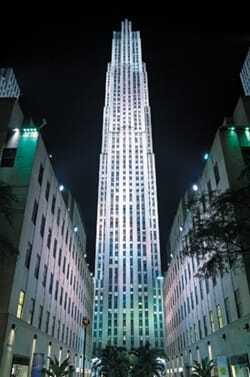ULI’s Heritage Award is given periodically to developments that have demonstrated industry excellence for at least 25 years.
Few places speak more eloquently in embodying the attributes of a ULI Heritage Award than its first honoree, in 1989, Rockefeller Center.
Yes, it speaks—speaks to many who are awed by its striking architecture and walkable public spaces, who connect emotionally to having attended a show by the Rockettes during the dance troupe’s 70 years, who have seen the traditional Christmas tree rise above the ice skating rink, or who have stepped inside one of the office, retail, or entertainment spaces in its six square blocks. Visually centered on the art deco masterpiece GE Building (originally known as the RCA Building), this city within a city is equally at home serving global corporate giants, luxury retailers, media concerns, or headline performances.
ULI’s Heritage Award, the organization’s most prestigious honor for a property, is not an annual award. Instead, it is given periodically to developments that have demonstrated industry excellence and made substantial contributions to the greater community’s well-being for at least 25 years. Folded into the ULI Awards for Excellence which highlight great projects every year, it is the only honor requiring a unanimous vote of the jury.
John D. Rockefeller, Jr., developed Rockefeller Center between 1929 and 1940, aiming to create a major destination development at the heart of Manhattan—interestingly enough, only after an original anchor tenant, the Metropolitan Opera, fell through. The principal architect for the project was Raymond Hood, but many architects and designers have taken part in creating this cohesive yet sprawling 22-acre (9-ha) campus originally bounded by the Avenue of the Americas (Sixth Avenue), 48th Street, Fifth Avenue, and 51st Street, but now inclusive of adjacent structures.
| ULI Heritage Award Winners 1989 Rockefeller Center New York, New York 1993 Country Club Plaza Kansas City, Missouri 1994 Sea Pines Plantation Hilton Head Island, South Carolina 1995 Disneyland Park Anaheim, California 1997 The Arizona Biltmore Phoenix, Arizona Hotel and Resort 2000 The Burnham Plan Chicago, Illinois 2005 The Chautauqua Institution Chautauqua, New York 2007 King’s Lynne Lynn, Massachusetts 2009 Baltimore Inner Harbor Baltimore, Maryland 2011 Battery Park City Master Plan New York, New York |
Recognition has been showered on Rockefeller Center over the years. The property’s original 12 buildings were declared a National Historic Landmark in 1988. The American Institute of Architects in 1976 declared Rockefeller Center the second-most-significant piece of architecture in America, topped only by Thomas Jefferson’s University of Virginia.
Rockefeller Center, owned by the Rockefeller family for two generations, briefly came under control of the Mitsubishi Estate before its acquisition in 1997 by a group of friends and colleagues of John D. Rockefeller, Jr., led by Tishman Speyer, Goldman Sachs, and others. In 2001, Tishman Speyer, together with a longstanding investment partner, purchased the other partners’ interests in Rockefeller Center.
Improvements have continued over the years, including most recently the Top of the Rock public viewing levels atop the GE Building, and the greatly improved public access to and information on its extensive art and sculpture collection.
Rockefeller Center’s timeless nature has been recognized by experts and critics far and wide. The American Institute of Architects, celebrating 150 years of the nation’s best designs in its book Architecture: Celebrating the Past, Designing the Future, called Rockefeller Center “one of New York’s and the country’s most successful and admired urban ensembles.”
Architecture critic Ada Louise Huxtable told the New York Times in 2008, “If you look at Rockefeller Center in detail, it’s a very elegant plan: higher and lower levels that lead you from one to the other, streets cut through to keep the human scale. You always feel you’re going . . . into some other area that has an inviting activity.”
“It is a national symbol of distinguished corporate design, far and away the finest grouping of skyscrapers ever built,” critic Paul Goldberger said in 1989. “Rockefeller Center has been the model for dozens of complexes around the world, but not one of them has come up to its quality.”
But no one has a better view than its current owner. Jerry Speyer, CEO of Tishman Speyer, called it “a singular real estate asset that has transcended time.”
Perhaps no better, more concise description could be made of the ULI Heritage Award itself.




